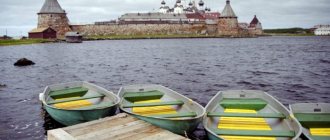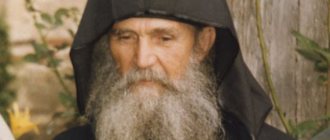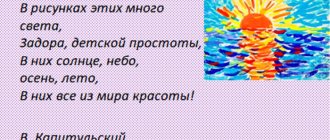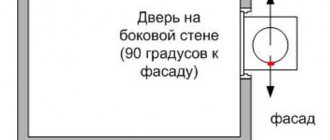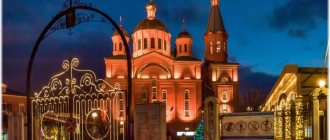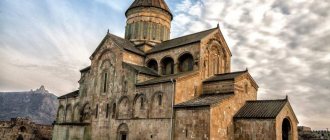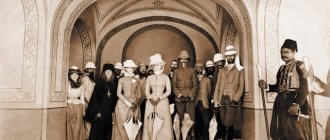When there was no Christmas tree yet
The tradition of decorating the Christmas tree appeared on the Apennine Peninsula in the 19th century. Before this, every family united at Christmas around a small home nativity scene.
It is called the Italian word “presepe” or “presepio” from the Latin “praesaepe” - animal feeder, nursery.
At first it was a miniature image of a Christmas manger. Four other figures depicted Mary and Joseph bending over the Infant Christ, an ox and a donkey kneeling.
Eyewitnesses described the empty rooms of the poor, in which there were only figures from the Nativity scene. They were carved from wood and carved from stone. In different regions of the Apennine Peninsula, terracotta, clay, and papier-mâché were used. The figurines were placed on the festive table or on the fireplace. And in the absence of a fireplace and a table - on the windowsill or on the floor.
Small nativity scene made of coral and ivory, created by Andrea and Alberto Tipa in 1700
And in rich houses, miniature Christmas nativity scenes were fashionable. They were jewelry masterpieces: they were made of gold and silver, coral and pearls, ivory and precious stones.
This technique was especially loved in Sicily: the smallest nativity scenes fit into a thimble; the larger ones are in a matchbox. They could be carried with you in your pocket or on a chain, like an amulet.
Modern nativity scene by Luigi Tramontano. Participant in the competition of the website www.presepio.it
By the 18th century, viewing home nativity scenes was considered top-level entertainment for foreign ambassadors and crowned heads.
In January 1734, a Neapolitan chronicler wrote: “The Vice-Queen, having examined the nativity scenes of our capital, went on Wednesday to see the nativity scene of the royal engineer Desiderio de Bonis... which, with its splendor, the skill of miniature architecture and the grace of the clothes of the dolls, aroused the admiration of the illustrious signora...”
The vice-queen probably spent more than one hour examining the nativity scene: its figurines were stored in dozens of cabinets and occupied several large halls.
Competition entry by Giuseppe Porcelluzzi from the website www.presepio.it. The area of this town has yet to be filled with figures.
Indeed, in the 18th century, new characters were added to the composition of the Christmas manger (actually “presepe”) in Italy: shepherds with sheep and dogs, wise men with camels and black servants, and King Herod with his gloomy soldiers. Other heroes were not listed anywhere except in popular imagination: among them are the shepherd Benino (who is always asleep), the girl Stefania, who dreams of worshiping Christ (and for this she is ready to throw a stone at an angel), the drunkard Cicci Bacco, the owners and visitors of the tavern, which the Holy Family did not allow...
Noon. The Holy Family is resting. Competition entry by Salvatore Maenza Source: website www.presepio.it
In many regions of Italy, Christmas characters of the local tradition appeared: in Bologna - a female figurine, with gestures depicting amazement, even shock, which is called Meraviglia (Surprise).
In Sicily - Dzu Innaru (Uncle January), in the form of an old man who warms himself by a lit fire.
In Tuscany - Gioioso, a boy expressing joy at the sight of a newborn baby.
Modern nativity scene by Nicola Nicolazzo. Source www.presepio.it
Nativity scene created by a modern African artist
Finding themselves next to the Christmas manger (not always on merit), these characters became members of a great community called “presepe”. Reflections of the glory of the Holy Family fell on them too. And the word “nativity scene” began to be applied to all the events of the Christmas mystery that played out in time and space and will continue to play out until the end of time.
At the bottom of the lake
Agostino Finchi's Salt Nativity Scene
There is no substance from which a Christmas nativity scene cannot be made.
Christmas figurines are made from gingerbread, sugar, fruit, and salt crystals (in salt mines). One of these nativity scenes by Agostino Finchi is even on display in the museum.
In December and January, aquariums organize exhibitions of underwater nativity scenes. Underwater Christmas sculptures are created from environmentally friendly sandstone and mounted on iron platforms.
They are installed in shallow water, in the clearest sea or lake water, so that the Nativity scene can be viewed from a bridge or from a high cliff.
Mary and Joseph kneel before an open sea shell containing the infant Christ. Two kind, curious dolphins pointed their noses at the shell.
In the north, on Lake Garda, in December-January, from the San Giovanni bridge near the Peschiera fortress, you can see the characters of the Christmas mystery shining under the night water. Camels, sheep, swaying palm trees and the shining Christmas star are not forgotten.
According to the belief of some regions of Italy, on Christmas Day the water becomes healing. The presence of Nativity scenes on or under water symbolically cleanses bodies of water.
Christmas morning in Rimini (Italy) source: www.patatofriendly.com
In one of the semicircular arches of the ancient bridge of the city of Rimini, worn from antiquity, floats a bright red raft with an image of the Holy Family. In the silence of Christmas morning, only the bare crowns of trees and the white feathers of clouds are reflected in the blue water.
It happened in Greccio
Giotto. The Legend of Saint Francis The Miracle of Greccio
Also during the Christmas period, live nativity scenes are organized on the peninsula. A small grotto is erected on the church porch or in the village square. Black and white sheep, roosters, chickens, and shepherd dogs nestle comfortably in the hay. A donkey trumpets in a paddock nearby, demanding attention to his person. In the grotto, Mary rocks a doll depicting the baby Jesus, talks with Joseph and with the angels.
Entire families take part in living nativity scenes, dressing up as wise men or shepherds, Herod's soldiers or the grieving mothers of Bethlehem. Where this tradition is maintained (for example, in the Gargano National Park in the province of Foggia), Christmas performances stretch over half a kilometer in the open air.
When, in 2013, participants in a living nativity scene in Caltanisetta (Sicily) decided to take a photo on the long porch of their cathedral, they had to stand in four rows to get into the frame.
The tradition of live nativity scenes dates back to the time of St. Francis of Assisi. “The Legend of Saint Francis” tells that he, nicknamed “poverello” (“poor man”), brought an ox and a donkey to the Christmas service and placed them in the temple next to a real manger. When the “poor man” began to pray for the birth of the King of the poor, the hearts of the parishioners trembled. Some saw how Saint Francis, during prayer, took the Child Christ from the empty manger into his arms and pressed him to his heart.
It happened on Christmas night 1223 in Greccio (province of Rieti). The miracle at the service in Greccio was depicted in the famous fresco by Giotto. It became the thirteenth fresco among the twenty-eight scenes from the life of St. Francis painted in the upper church of the temple in Assisi (1295-1299). This fresco laid the foundation for the tradition of the Nativity scene associated with the name of St. Francis.
Crafts from plasticine
Modeling from plasticine is a fascinating activity not only for children, but also for adults. High-quality bright material can make very cute figures for a nativity scene. Plasticine is good because it does not harden and does not lose its properties during modeling. You can make a fireplace with a pot, or make a figurine of the Virgin Mary holding a child in her arms.
When the plasticine modeling work is completed, you need to place the figures in the refrigerator. This material hardens at low temperatures, so the workpieces will become dense and will hold their shape well.
With my own hands
Nativity scene made of sand and polystyrene foam from a TV
At the end of the year, many Italians begin to worry about the question: how to make a Christmas nativity scene if there are no funds in the house, but there are skillful hands? Sites that post DIY tips are seeing record numbers of visits in December.
For example, find a styrofoam TV box, a desert wallpaper, a string of light bulbs, and a box of sand. Put all this in front of yourself, watch the video and do as we do.
What if there is no room in the house? Take a crystal glass, put several glass balls in it, a little moss on them, attach miniature figures of the Baby in the manger and the Holy Family on the moss. Place the glass between two candles. Merry Christmas!
Modern nativity scene by Pino Bozzarelli, submitted for a competition on the website www.presepio.it
It's perfectly acceptable to fill your nativity scene with your children's favorite toys. Therefore, at the Christmas nursery there are toy cars, little Santa Clauses, and a variety of toys that also come to worship the Infant Christ. And if a child has a toy car, why don't the Magi drive across the desert in a white toy trailer?
Making your own Christmas nativity scene is one of the most respected arts on the Apennine Peninsula.
The best Christmas nativity scenes are kept in the collections of art museums, folk art museums and private collections. There are even special museums created for them.
The Holy Family on vacation. Detail of another nativity scene by Pino Bozzarelli
Since 1953, the Italian Association of Friends of the Nativity Scene has published the magazine “The Nativity Scene” (Il Presepio). Its members post their work on the site. The authors, who participate in the competition for the best Christmas nativity scene every year, emphasize that they made all the figures with their own hands. “My nativity scene is completely handmade,” says one of the competition participants. Liliana Campo. – It can be deployed 360%. Its dimensions are 30 by 40 by 35 cm. It took 90 days to make it.”
How to create a nativity scene?
There are a considerable number of options for creating a work. It all depends on your creativity and limitless imagination. The design can be either simple or highly professional. Let's consider popular and simple models that are created from funds that everyone has at hand.
The process is similar to organizing a dollhouse, so the basis can be a box with a cut out wall, an inverted basket, a regular construction set or game cubes, collected branches of brushwood in the form of a hut:
On the sides of the ensemble you can place decorative artificial plants and flowers in pots. The location of the nativity scene under an elegant New Year tree looks interesting, in addition to cotton wool representing snow, a thin layer of salt, sugar, and in some cases even glitter sprinkled on glue.
The floor in the composition can be made in the form of a stone filling using poured lentils or beans. The cardboard base is harmoniously replaced by ordinary draped fabric:
It’s great if you can highlight the composition with a garland. This creates a festive atmosphere:
Miracle of Christmas
A competition nativity scene by Joseph Schorra that combines American and Italian traditions. Source www.presepio.it
A small home nativity scene is usually installed in the middle of the living room. It is often placed on a round stand so that children and adults can look at it from all sides. Sometimes it looks like a rocky hill, twisting in a spiral. Shepherds with sheep and dogs, wise men with their gifts, peasants, artisans, robbers, descend or ascend in a spiral. They are watched from above by a golden star and a barefoot angel with huge white wings.
Sometimes the spiral twists along the stairs of dilapidated palaces. It was their ruins that in the 17th and 18th centuries were a refuge for travelers who could not find a place in the hotel. One by one, the Magi ascend to the second floor, dragging their precious robes along the chipped steps. And through the front door a cheerful peddler with a tray is already hurrying after the guests, who is also in a hurry to bring his gifts to the Holy Family. Now others will seep through the door behind him. Some will bring gifts, others will be curious.
Another nativity scene by Joseph Schorra that brings modernity to the heart of tradition.
Soon you will not be able to find the Holy Family in this crowd. But this is the lesson: we do not know how to recognize the heavenly in the earthly.
The story of Christmas appears before us as the story of a community of people who witnessed the most amazing events, but continue to live in everyday life: washing clothes, preparing food, receiving guests. The miracle of Christmas entered the core of their existence, like a shell. Its doors have closed, and the pearl is ripening in silence.
The Savior was born for these people. Therefore, they are the main ones here. The nativity scene in its Italian tradition is a view from above the Christmas star.
Our neighbors in the cave
First depiction of the Nativity in the Catacombs of Priscilla, Rome
People often ask: where is the Christmas cave? For most southern Italian cities, caves - like the one in which the Holy Family took refuge - were as much a fact of life as a clothesline across the street from window to window or a pot of basil on the windowsill.
In Naples, in order to go down to the catacombs, you just need to turn the corner and take the gate keys from the gatekeeper. In the Italian Basilicata, caves are ordinary village dwellings.
Oh, Maria and Giuseppe? Of course we do! They occupied a nearby cave. These are our neighbors across the wall!
A modern nativity scene made by Pino Bozzarelli tells the story of this neighborhood. It contains two parts, enclosed in a wooden frame with the inscription “Per loro non c'era posto...” (“There was no room for them in the hotel”).
On the left is the hotel that could not accommodate the Holy Family on Christmas night. On the ground floor, the housewife feeds the chickens, and her daughter hugs a calf that has just left the nursery. Behind the brick wall is a barn in which the Holy Family found shelter. In the barn, everything looks the same, only more comfortable: hay is drying in the gallery, a tired donkey is happily lying down on the straw, a lantern hanging from a beam is burning... And white doves are sitting in the niches of the windows both here and here.
Jesus Christ, the Son of God, was born in a den where the Virgin Mary and Joseph stopped for the night
What is a nativity scene? Nativity scene is an ancient Greek word that means “cave.” According to the Holy Scriptures, Jesus Christ, the Son of God, was born in the den where the Most Holy Theotokos and Righteous Joseph stopped for the night.
The evangelists Luke and Matthew narrate about the birth of the Savior. Everyone lived with the hope that the Messiah would come, who would be able to correct the consequences of Adam’s sin, and also accept all humanity and save them from destruction. All the books of the Old Testament indicated that all this would come to pass.
At that time, all of Rome was under the rule of Judea. Emperor Augustine decided to announce a worldwide census.
The betrothed of the Virgin Mary - Joseph and the Blessed Virgin Mary were descendants of King David, they went to Bethlehem, but all the hotels were full. Since the Virgin Mary was expecting the imminent birth of Jesus Christ, they were simply forced to stop for the night outside the city, in an ordinary cave.
Since the Virgin Mary was expecting the imminent birth of Jesus Christ, they were simply forced to stop with righteous Joseph for the night outside the city, in an ordinary cave
The Savior, whose birth the whole world was waiting for, was born in a cave. The Most Holy Theotokos wrapped Him in swaddling clothes and placed Him in a manger—a feeding trough for livestock. The whole world was sleeping, and only the Angel who appeared to the shepherds announced that the Savior had been born into the world. This is depicted in many icons and paintings.
An angel of the Lord visited the shepherds and informed them of the birth of Jesus
Day or night?
Neapolitan nativity scene
In 1707, the Viceroy of Austria, who visited Naples, admired the nativity scene with an unusual lighting system: it allowed the alternation of day and night. The cosmic essence of the Christmas nativity scene is such that after the night the morning must come. And after an alarming sunset, the earth is embraced by a night of peace,
Nativity scene in the Cathedral of the Assumption of the Virgin Mary in Castellammare
The Neapolitan nativity scene must be immersed in darkness. It is illuminated only by the long tail of the Christmas star, cutting through the sky like a curved blade.
A cold winter morning can reign in the den of a Bolognese school: a pale, anxious dawn, the street of a poor Italian town, sheep looking for food among the street stones, kneeling king-magi in golden crowns and mothers with babies who have come to worship the newborn God.
In the nativity scenes from the province of Marche, the mystery of Christmas is played out on a bright day, on a sea pier. Shepherds descend a steep cliff to the azure pier, where the Holy Family took refuge in a boat shed. The boat with the sail deployed is ready to be launched. On the seat is a wicker basket with apples.
Materials
The nativity scene has long been a field for creativity. They experiment with both manufacturing techniques and materials. You can often notice the use of materials such as ceramics, wood, wax, paper, plastic, metal. But there are simpler options: plasticine, salt dough, felt, polymer clay.
Sometimes unusual materials are used. For example, in Maslovice, Czech Republic, since 2000, curious people can see a nativity scene made of butter. Many people know about gingerbread nativity scenes, but for obvious reasons they prefer to buy them from craftsmen. This article discusses the option of making your own crafts, so at the end you will find a step-by-step master class.
Sweet taste of details
Bologna. Adoration of the Magi
In 1825, under the king of Naples, Francis 1 of Bourbon, an amazing document was drawn up, which was called “Inventory of all the shepherds, wise men, animals, gifts and provisions of the Royal Den.”
The Christmas nativity scene is not only about the wise men and shepherds. This also includes gifts and food!
The world in which the Holy Family lives is filled with various carts with fruits and flowers, piles of watermelons and melons. The ceiling beams of the houses are bursting with cheeses, sausages, onions, tomatoes in nets, dried vegetables and fruits, snow-white fringes of spaghetti hanging out to dry.
19th century nativity scene in Rome in Piazza di Spagna
The Christmas miracle embodied in the nativity scene is born out of love for every inch of the world around us. Boxes of flowers on a small wooden balcony, a pot on the fireplace, dishes on a shelf, even shovels leaning against the wall - every item should feel like you're in love with it!
Today, in online stores of Christmas figurines you can buy miniature plates with traditional dishes and stands with all kinds of food. For those who create a home nativity scene with their own hands, master classes are announced: what dishes should be “put” in plates in order to maintain the tradition?
Genoa. Fragment of a nativity scene. Sellers of figurines for nativity scenes
Artists so carefully reproduced the details of historical feasts, were so attentive to the details of costumes or to the furnishings of peasant houses of the 18th-20th centuries, that using Christmas nativity scenes it is now possible to study the history of life in a particular region.
The classic 19th-century nativity scene, which is on display in Rome during the Christmas holidays (on the stairs leading to Trinity Church on the Hills), seems like a “time machine”: if you look closely, you can see Roman outfits from the time of Giuseppe Gioachino Belli and his friend Nikolai Gogol: here and the dandy in top hat and romantic cloak, and girls in dresses that could have been worn by the beautiful Annunziata from Gogol’s story “Rome.”
Nativity scene using toys
When creating a design with your own hands, you can easily dilute it with the help of figurines of angels and animals from existing souvenirs or toy sets. Festive tinsel and herbarium elements will make your nativity scene unique!
Do you know how to crochet? It is possible to create a unique version with knitted elements. And even completely knitted!
Peacocks, cheetahs, monkeys, elephants...
Arnolfo di Cambio. Nativity scene in the Basilica of Santa Maria Maggiore, Rome
One of the first nativity scenes in which the sculptor attempted to depict animals was the “Grotto of the Nativity” by Arnolfo di Cambio (1289) in the Roman Basilica of Santa Maria Maggiore. The attempt was not the most successful: only the heads of the ox and donkey remained. In 1478, the court apothecary of the Duke of Calabria did not share the mistrust of animal depictions. Perhaps the pharmacist had children or grandchildren. But he ordered forty-one figures for his home den, including eleven sheep and two dogs!
In the same 15th century in Europe, peacocks and cheetahs first appeared among the witnesses of Christmas. A dark blue peacock, flying onto the wicker roof of the manger, arches its neck to look at its magnificent tail, folded in a sign of humility, in the famous circular painting “The Adoration of the Magi” (1440-1460) by Fra Filippo Lippi and Fra Beato Angelico.
In the first years of the 15th century, the Limburg brothers depicted on the page of the famous “Luxury Book of Hours” of the Duke of Berry a pair of cheetahs in red collars, sitting trustingly at the feet of the Mother of God. Cheetahs, then called game leopards, were considered the only big cats that could be domesticated. In Europe, kings and dukes hunted with cheetahs (pardus); in Rus' - princes. Cheetahs, as a symbol of the humility of rebellious nature, were brought with them to the Christmas manger by the Magi Kings.
One of the last images of cheetahs as a symbolic animal of Christmas remains the miniatures of the Farnese Book of Hours, made in 1546 by the Croatian artist Giulio Clovio.
Later, in the 17th century, monkeys became guests of the Christmas nativity scene. Then, with an important step, lions and elephants walked towards the manger, which the servants of the Magi Kings brought on leashes from Africa. In Naples, buffaloes played their role in the mysteries of Christmas, from whose milk mozzarella cheese was already made.
Nativity scene of the Bolognese school
In the 18th century, among the craftsmen who made sculptures for Neapolitan nativity scenes, the brothers Nicola and Saverio Vassallo were famous: Saverio liked to make figurines of goats and sheep. Nikola carved camels, dogs, mules, bulls and even piglets from wood.
By the way, modern creators of nativity scenes from time to time release a pink pig into the Christmas world, which trustingly moves its snout, in the hope that it will not be made into sausages for the holiday.
